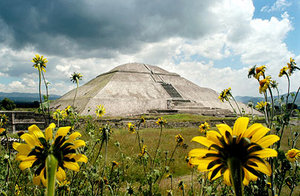
|
| The Aztecs believed the city was divine and identified it with the place where the sun was created |
Archaeologists are to open a long-sealed cave under a Mexican pyramid in the hope that it will unlock the mystery of one of ancient civilisation's greatest cities.
With its soaring stone pyramids and geometric temples, Teotihuacan was once the biggest city in the Americas and possibly the world.
However, experts have never been able to say with certainty who built it and why it was suddenly abandoned.
An international team of experts believes the answer may lie under the Pyramid of the Sun, the centre point of the vast ruined city 25 miles outside Mexico City.
At the end of this month, they are to investigate a man-made tunnel and cave system underneath the pyramid - the third biggest in the world - to test theories that it was used for rituals including human sacrifice.
"We think it had a ritual purpose. Offerings were placed at the very end of the tunnel as part of the pyramid's construction process," said Alejandro Sarabia, Teotihuacan's director of archaeology.
He will lead a team of Mexican, American and Japanese experts into a 295 ft long, 8 ft high tunnel some 20 ft below the pyramid.
"We want to find out why the Teotihuacan people sealed it and when," Mr Sarabia said. "Excavating the cave could give us some clues about what happened at Teotihuacan, about the fate of the city."
At its zenith between 150 AD and 450 AD, Teotihuacan was home to up to 200,000 people of various ethnic origins and thought to have been larger than any European city at the time, including Rome.
But, sometime in the 7th or 8th century, it was set ablaze - possibly as the result of an insurrection - and abandoned.
Comment: Or perhaps it was set ablaze from a meteor strike.
The Aztecs believed the city was divine and identified it with the place where the sun was created. They also gave it its name, which roughly translates as ''The place where men became gods.''
The tunnel entrance was discovered by accident in 1971 while workmen were installing a sound and light show for the 738 ft wide pyramid.
After initial tests, it was dismissed as a natural cave and sealed two years later. Much of the information about it was lost when the archaeologist who found it died.
Mr Sarabia said: "If we can find out what happened, when, and perhaps how, it will give us a better idea about the history of the Pyramid of the Sun and of the city in general."
He said it was unlikely that the cave would have been used for everyday events and would probably have been accessible to only a select few.
"It may well have been used for sacrificial rites, dancing or other rituals," Mr Sarabia said.
The sacrifices are likely to have been human ones, he added.
Evidence of human sacrifice has been found all around the city, including the remains of children buried at each corner of the Pyramid of the Sun.
It is believed these burials were part of a ritual dedication of the building while other victims, probably captured enemy warriors, were killed to bring the city good luck.
Mr Sarabia said the excavation work would be "tricky" because there was virtually no light and the entrance to the tunnel was in poor condition.
For many years, archaeologists believed the city was built by the Toltecs but it is now accepted that their civilisation came centuries later.
Teothiuacan, which has World Heritage Site status, is still visited by thousands each year to celebrate the spring equinox.



Reader Comments
to our Newsletter